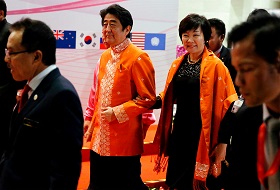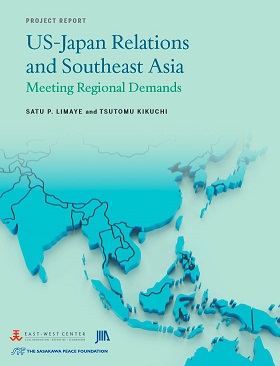Japan–US Union and Southeast Asia: Getting closer to cement the status quo?
Japan Maritime Self-Defense Force guided
missile destroyer Kirishima is seen from
the flight deck of USS George Washington
during military manoeuvre exercises in
the sea south of Japan
(no votes) |
(0 votes) |
As French publicist Alphonse Karr fairly put it, “the more it changes, the more it’s the same thing.” The logic of maintaining the status quo by seeking changes as the core idea of the convergence between the Japan–US alliance and Southeast Asia can be discovered in the recently published report by the Hawaii-based East-West Center US-Japan Relations and Southeast Asia. Meeting Regional Demands. As it follows from the title of the report and its message, its authors Satu P. Limaye and Tsutomu Kikuchi call for Washington and Tokyo to show strategic initiative in the region, while drawing on the requests of Southeast Asian countries to form new partnerships.
As French publicist Alphonse Karr fairly put it, “the more it changes, the more it’s the same thing.” The logic of maintaining the status quo by seeking changes as the core idea of the convergence between the Japan–US alliance and Southeast Asia can be discovered in the recently published report by the Hawaii-based East-West Center US-Japan Relations and Southeast Asia. Meeting Regional Demands. As it follows from the title of the report and its message, its authors Satu P. Limaye and Tsutomu Kikuchi call for Washington and Tokyo to show strategic initiative in the region, while drawing on the requests of Southeast Asian countries to form new partnerships.
Background
The security treaty between the US and Japan signed back in 1960 is one of the pillars of the US strategic presence in Asia and arguably the most robust of all. Incidentally, the treaty was inked under Prime Minister NobusukeKishi, the grandfather of Shinzō Abe and crucial landmark for the current head of the Japanese government. Until recently, Southeast Asia had not been a region of focus for the US-Japan relationship, the report reads. Since the end of the Cold War, Northeast Asia has remained Japan’s main security perimeter (we will have more on the regional pattern later), and the DPRK and PRC were considered the principal threats. The importance of Southeast Asia for both Japan and the US remained mostly in the economic dimension, although several major economies of the region — Thailand, the Philippines, and partially Indonesia — have close direct contacts with the Pentagon in the defense sector. The report under analysis suggests spreading the scope of the Japan–US collaboration over Southeast Asia.
The echo of the Japan–China confrontation with respect to Southeast Asia has reverberated in global institutions, which became quite apparent in 2016 due to Japan’s G7 Presidency and China’s G20 Presidency.
There is a variety of prerequisites for this. First, the region of the South China Sea is growing increasingly unstable — the main challenges being the disputed territories and piracy: Southeast Asia accounted for up to 41% of all attacks by pirates during the last two decades. Further, the US servicemen and the Japan Self-Defense Forces proved quite effective in dealing with the aftermath of the nuclear disaster at the Fukushima No. 1 plant, and the report proposes to apply this experience to frequent natural disasters in Southeast Asia. Second, the security legislation passed by the Abe cabinet increased Japan’s collective defense capacity, enabling it to pursue broader cooperation with other countries’ armies, especially with the US and Southeast Asia. Specifically, Abe managed to have his country mitigate the self-limitation imposed on the export of defense technologies and equipment. ASEAN is expected to become the main beneficiary: the authors of the report call for redoubling efforts to build its defense capacity.
Finally, it is about the US ambition to have a broader security cooperation network in an increasingly multipolar Asia by being engaged in various formats with a view to maintaining the existing security architecture. The countries of the north and south of the Asia-Pacific Region might have various visions of the regional security order: while the US and Japan call for a rules-based order, Southeast Asian experts warn their US and Japanese counterparts against focusing on rules and recommend promoting universal values instead. This pattern may run counter to the ASEAN Way, because ASEAN brings together countries with various political systems and believes the alignment of its members to be the core value. In addition to pragmatic aspects, the report provides ample room for conceptual interpretations: from the theory of the balance of forces to the (re)construction of regions.
North and South of East Asia
In addition to the apparent designation of the subregions of Asia, the notions of Northeast Asia and Southeast Asia should be regarded in a special historical and political context, which is partially a legacy of the Cold War. The Japanese international relations expert Akihiro Iwashita points to the constructedness of the Northeast Asia concept alongside Southeast Asia as platforms for the projection of the US foreign policy in the strategic combat against communist nations or movements — the USSR, China, and the DPRK in the north and Vietnam, Cambodia, and Laos in the south. However, in the case with Southeast Asia the political and cultural diversity of the nations did not become an obstacle enough for them to form ASEAN and subsequently embrace the former Cold War opponents, whereas Northeast Asia is still characterized by serious discrepancies even between allies, such as the US, Japan, and Korea.
In the case with Southeast Asia the political and cultural diversity of the nations did not become an obstacle enough for them to form ASEAN and subsequently embrace the former Cold War opponents, whereas Northeast Asia is still characterized by serious discrepancies even between allies, such as the US, Japan, and Korea.
The challenges faced by Northeast Asia are addressed in more detail in The Making of Northeast Asia (2010) by Kent Calder and Min Ye [1]. Specifically, the authors refer to the “organizational deficit” inside Northeast Asia, which prevents collective cooperation and draws a conclusion that in the history of the region security meltdowns, such as the Taiwan or Korea crises, have had much more serious institutional consequences than financial slumps.
At the same time, Calder and Ye emphasize the gap between Eastern Asian regionalism and that European, which is manifested in the predominance of informal and apolitical networks. This “soft institutionalism” is especially apparent in ASEAN and it cannot be ruled out that the outcome of the convergence between the US–Japan Alliance with Southeast Asia will encourage the rationalism dynamics in the entire East Asian region, including in the northeast. On the other hand, it was mentioned in the report that Japan is no longer the only major nation in Northeast Asia that has active operations in Southeast Asia, and its relationships with China and South Korea produce a direct impact on ASEAN. Therefore, the prospect of the possible “reconstruction” of the Asian subregions in the foreign policy agenda and related discourse appears to be associated with the balance of forces in Asia.
From constructivism to neorealism

Nikolai Murashkin:
Japan-ASEAN: an Inevitable Partnership in
a New Asian Order?
So long as the contemporary framework of international relations in East Asia is characterized by the shift in the balance of forces towards China, the response of the regional powers in terms of internal and external balancing, as well as bandwagoning — coined by Kenneth Waltz — or a combination of two (the so-called hedging) has become a default option.
Internal balancing incorporates — in addition to economic incentives — efforts to build up a country’s defense potential. This trend is especially apparent in Asian countries, where military spending is growing amid global cuts in the defense bill. From the perspective of exporters of military equipment, including those from Russia, this trend stands for an additional market capacity. From the point of view of the APR stakeholders, including Russia, which have their own development plans within the region at stake, the encouragement of the already high conflict potential in Asia is a threat.
External balancing implies stronger foreign alliances, whereas bandwagoning stands for weaker states joining either the existing hegemon or the main contender for that status. In Southeast Asia, both types of conduct can be observed: security cooperation has been growing stronger between the countries of the region, whereas when picking external “patrons” some countries chose in favor of China (Cambodia, the DPRK, Laos, and Myanmar), and others preferred the US (Thailand, the Philippines, etc.).
In this context, Washington is faced with several dilemmas. First, the US will need to contrive to prevent many countries of the region from joining China as the prospective hegemon while avoiding the role of the “regional policeman” and without irritating Beijing. The East-WestCenter report points to the concern of some Southeast Asian countries over the possible confrontation with China. Second, although the initiative for the US to establish closer ties with Southeast Asia is comparatively stronger than the “local” demand, its top-down promotion based on direct orders will hardly satisfy either party, given that the countries of the region insist on the ASEAN-centric process. In this context, there are several reasons why Tokyo can become a regional partner and middleman, the more so because the public perception of Japan and Abe in Southeast Asia is quite positive.
“Security diamonds” and geometry of partnerships
Both Abe and US President Obama have had numerous visits to Southeast Asia during their respective terms. The American “turn to Asia” declared in 2009 resonated with the “proactive pacifism” of Prime Minister Abe, who came back to power in 2012. Abe originally put forward the concept of “democratic security diamond” envisaging work to strengthen ties along the diamond contours of Japan–India–Australia–Hawaii (as a US state) to maintain the status quo. In particular, Abe made a warning in the concept that the South China Sea might turn into “Beijing Lake,” the Chinese equivalent of the Sea of Okhotsk, the home station of nuclear submarines. The “security diamond” never became a pillar of Japan’s diplomacy, although Abe continued promoting the country’s relationships with Washington, Delhi, and Canberra, while pursuing dialogue with Beijing as well.
The report explores ways to not only intensify the bilateral dialogue of the defense ministries, but also promote trilateral and quadrilateral partnerships taking the shape of the said “diamond,” among others, within the framework of ASEAN+2 and on the sidelines of ADMMPlus. These security polygons are designed to engage primarily Vietnam and the Philippines — the countries of the region that are especially close to Japan. Against this backdrop contacts between the Japanese and Chinese defense ministries, which had been phased down over the past five years, will be a glaring contrast.
Another reason why Japan appears to be a good partner for the US is the need for it to balance between pragmatism and ideology given the diversity of political systems within ASEAN. Abe never hesitates to combine his commitment to democratic values with pragmatism, especially when it comes to the rivalry between Japan and China, which is not restrained to the Asian region.
Tokyo–Beijing duel andJapan’s growing weight category
Abe still of remaining in power at least until 2018, even if an early election to the lower house is called in 2016.
The echo of the Japan–China confrontation with respect to Southeast Asia has reverberated in global institutions, which became quite apparent in 2016 due to Japan’s G7 Presidency and China’s G20 Presidency. Abe is poised to raise the issue of disputed territories in the South China Sea at the G7 Summit, which China is seeking to block. The final agenda of the summits at Ise-Shima and Hangzhou will show the way the global community is going to respond to the tensions between Japan and China.
At the local level, a new example of Abe’s pragmatism is the visit of Zimbabwean President Robert Mugabe to Tokyo and Japan’s willingness to offer the African country a 600 million-yen (USD 5.3 million) infrastructure development loan. On the one hand, the amount is not critical for Japan and the road construction sector, whereas the priority of infrastructure projects has always been stressed by Japanese economists. On the other hand, even though Japan substantially contributes to the promotion of development in Africa, the relationship between Zimbabwe and Japan, which publicly commits to democratic values, could be different if it were not for China’s expansion in the continent and Beijing’s opposition to Japan’s campaign to become a permanent member of the UN Security Council.
Getting back to Southeast Asia, it should be noted that the authors of the report believe that the strategic use of Japan’s assistance in the development of Southeast Asia is a prerequisite for an increased role of Japan in regional security. Incidentally, the direct proportion between military spending and financial promotion of development is characteristic mostly of developed nations, according to the Global Peace Index. Japan — a major global donor with the world’s seventh-largest military budget (in absolute figures) and military expenditures of not more than 1% of GDP — did not become an exception. During Abe’s tenure, the defense bill kept growing for four years, reaching a new record high of USD 44 billion in 2016.
Japan’s defense dialectic

Konstantin Sarkisov:
Japan-US-China Triangle and Security in East
Asia: a Triangle or an Axis?
The importance of pragmatism for the Japanese political elites can be illustrated by quoting the former Japanese ambassador to Thailand Hisahiko Okazaki, a champion of a close union with the US and longstanding advisor to both Abe and National Security Advisor ShotaroYachi, Abe’s right-hand man. In 1992, Okazaki emphasized the importance of geopolitical imperatives by giving this answer to a US journalist’s question about Japan’s foreign policy principles: “Your country was built on principles. Japan was built on an archipelago” [2]. Although during the past years, the situation in the region has changed, one can still observe the continuity of the strategic vision of right-wing conservatives in Tokyo. Amid the increasing — and encouraged by the US — autonomy of Japan in security issues, the union of the two countries has grown stronger, and attempts to revise it, for example under Yukio Hatoyama, failed.
Moreover, according to Giulio Pugliese at the University of Heidelberg, as a result of the expansion of the defense collaboration with the US in 2015 Washington gained additional leverage in its relations with Tokyo [3]. In exchange for the inclusion of the disputed islands of Senkaku/Diaoyu in the scope of the pact and ensuing support by the US, albeit on somewhat vague terms, Japan decided to lend the US a shoulder in the South China Sea issue, possibly doing the US too much of a favor, because Washington clearly benefitted more than Tokyo did [4]. Anyway, experts differ on this: US presidential candidate Donald Trump believes Japan and South Korea benefit a lot more from their union with the US than Washington and has advised them to build their own nuclear arsenals while promising them to withdraw US forces from both countries if the two East Asian allies failed to markedly increase their contributions.
The Japanese public is much more concerned over the situation in the East China Sea, where Senkaku is located, than the South China Sea issue. One logical question is how the engagement between the US and Japan in the security sector, including its covering the South China Sea and concern over the rise of China, will get through Abe’s term of office. So far the situation has been quite favorable for the premier: the Cabinet’s approval rating has remained close to 47%, which is quite acceptable for Japan, the degree of public opposition to amendments to the country’s security regulations has decreased, and the internal economic policy has traditionally prevailed over foreign policies. Abe still has a chance of remaining in power at least until 2018, even if an early election to the lower house is called in 2016. Therefore, in the mid-term, one should expect the current trend to continue subject to certain restrictions imposed by the summer election to the upper chamber of the Japanese parliament and the US presidential election.
Russia, a Northeaster Asian country with ambition to deepen APR integration, should keep an eye on tectonic shifts in Asian security and maintain a dynamic equilibrium to the best of its ability. Informal ties in East Asia are particularly important; therefore, it is crucial that Russia should be present at various regional formats and defense dialogues, including track one and a half and track two regardless the loyalty of such platforms to any country. Russia’s national interests should benefit from maintaining the regional balance of interests and simultaneous strengthening of relationships with various “poles” of multipolar Asia without joining any bloc. Russia’s Arctic cooperation with Northeast Asia can become a good example of promising functional engagement. Arms control on a regional level is also important, for a lot will depend on Russia’s military and technical cooperation with ASEAN. To put it in simple words, in conditions of the Cold Peace in Asia, it is important to keep cool.
1. Kent Calder & Min Ye, The Making of Northeast Asia, Princeton: Princeton University Press, 2010.
2. Okazaki, Hisahiko, “Ajia chōtaiken e no shinsenryaku,” This is Yomiuri, August 1992, pp.42-90. Цитируется по источнику: Kenneth Pyle, Japan Rising: The Resurgence of Japanese Power and Purpose, New York: Public Affairs, 2007.
3. <p><a name=">3. Pugliese, Giulio, “Japan 2015: Confronting East Asia’s Geopolitical Game of Go,” Asia Maior XXVI, edited by Michelguglielmo Torri and Nicola Mocci, forthcoming, 2016.
4. Ibid.
(no votes) |
(0 votes) |






